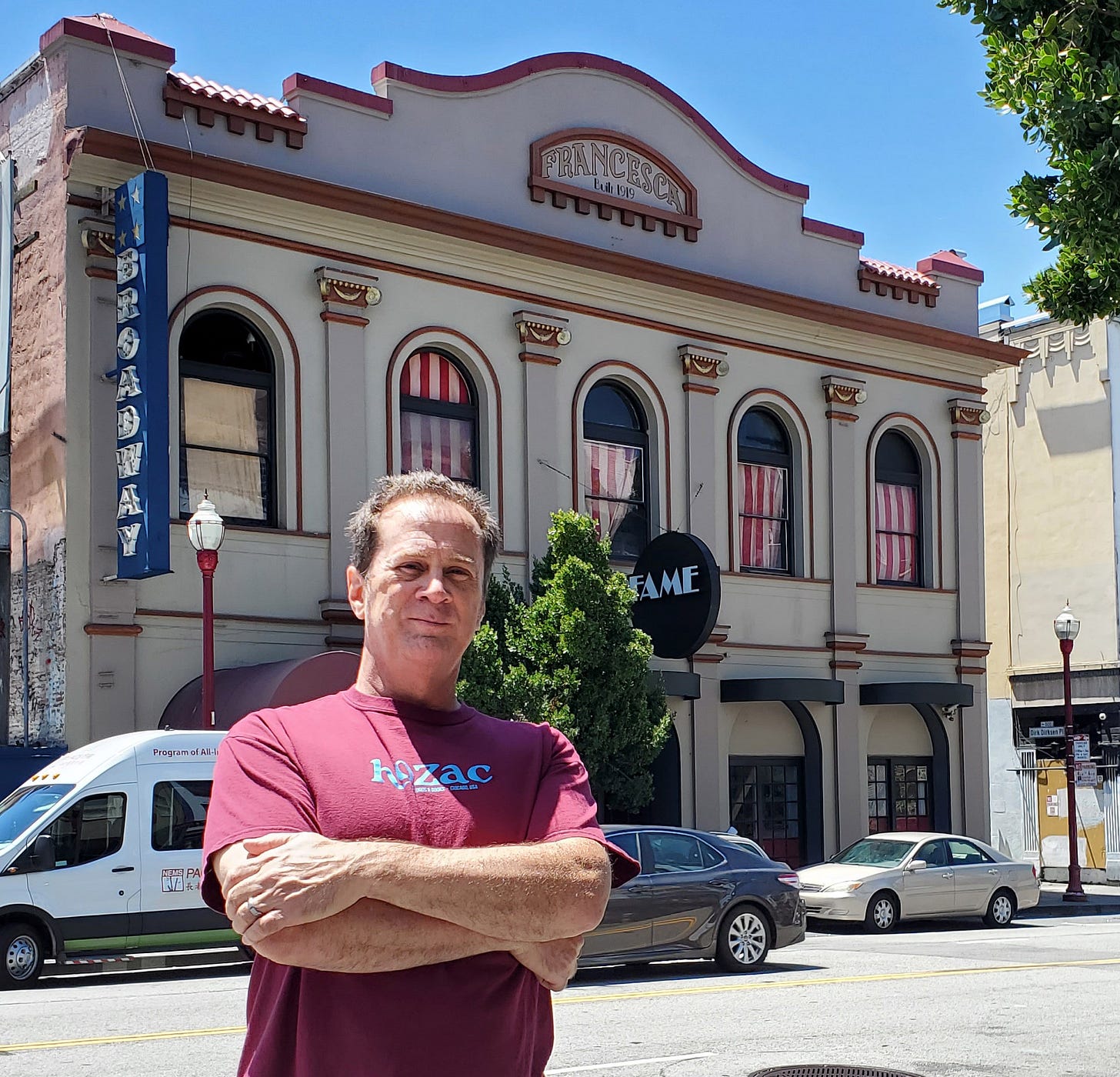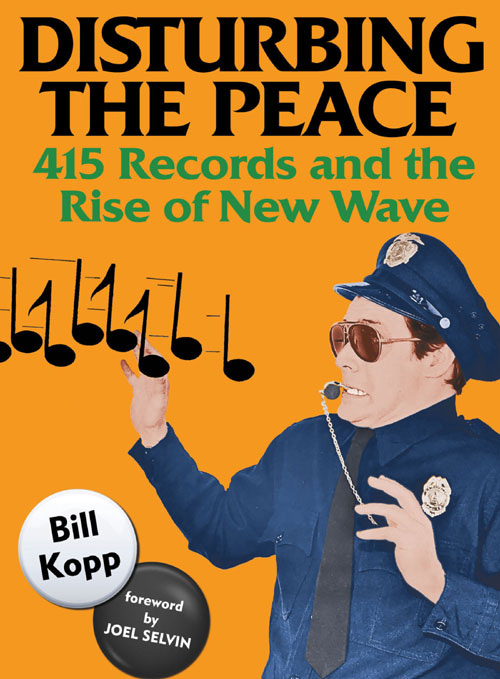
The late ‘70s and early ‘80s was a golden era for regionally-focused indie record labels. London had Stiff Records, Minneapolis had Twin/Tone, Washington D.C. had Dischord, Southern California had SST, to name a few. And, for about a decade, San Francisco had 415 Records—the focus of Bill Kopp’s excellent book, Disturbing the Peace: 415 Records and the Rise of New Wave (Hozac, 2021).
415 Records was originally founded in 1978 by three music-obsessed friends: Howie Klein, a KUSF radio DJ; Chris Knab, owner of an eclectic local record store, and silent partner/avid record collector Butch Bridges. The label was also briefly home to future Grammy-winner David Kahne (Paul McCartney, The Bangles, The Strokes, Lana del Ray, et al.), 415’s Director of A&R and de facto in-house producer.
Together they built an unlikely punk/post punk/power pop/new wave powerhouse that released some of the most vital (if obscure) music of the day—although 415 Records isn’t always mentioned in the same breath as their indie label contemporaries.
“415 was different from some of those labels in a couple of ways. First, with one or two notable exceptions, its roster reflected a particular slice of the music scene in one single American city: San Francisco. So it has a character unique and specific to that time and place, making it historically valuable,” said Kopp, an experienced music journalist who is a contributing editor at Goldmine magazine and owner of Musoscribe.
“Two, because the original motivations of Howie Klein and Chris Knab were not profit-centered, the label also reflected the personal tastes of those two men (along with that of unofficial house producer David Kahne). Their decisions about whom to sign weren’t based on commercial, will-it-sell considerations.”
In Disturbing the Peace, Kopp describes the eclectic San Francisco music scene that lived at the nexus of Mabuhay Gardens and KUSF, and how it gave birth to 415 Records. His well-researched book features quotes from the label’s major players and many artists, providing a detailed account of how 415 evolved from a haphazard singles operation to a minor hit factory for Columbia Records—before fizzling out.
Kopp goes release-by-release to cover all the bands that worked with 415 Records, from cult favorites like The Nuns, Pearl Harbor and the Explosions, SVT, The Readymades, and Roky Erickson and the Aliens, to more mainstream acts like Romeo Void, Wire Train and Translator. Taken all together it’s a fascinating tale about an important, but often-overlooked era in San Francisco’s music history.
I interviewed Kopp about Disturbing the Peace by email and asked him to share his five favorite 415 Records songs. Those tracks are woven throughout the interview below, but Kopp reserves the right to revise the list at any moment.
Bill Kopp Interview
I tore through Disturbing the Peace. What was the inspiration to write this book?
I’m pleased that you like it. It was incredibly fun to research and write.
In fall 2020, I got a heads-up from Cary Baker about an upcoming compilation CD. At the time, Cary—a major figure in the music journalism and PR worlds—was head of Conqueroo, the boutique music PR outfit (he retired last year). In addition to being one of my favorite publicists to deal with, he’s also my mentor and a close friend. So with me always on the lookout for interesting releases, tours and whatnot as subjects of potential story pitches, I was already interested.
It happened that the CD in question would be a compilation of tracks by bands of the late ‘70s who released music on what was then a tiny independent label, San Francisco-based 415 Records. When I learned that, my interest was doubly piqued for two reasons. One, I recognized the 415 imprint on some of my favorite albums, and two, since I write for a number of Bay Area publications (most significantly at that point, SF Weekly), I thought that this could have the makings of a big story, one that I could get published.
My editor at SF Weekly agreed, and so I set about scheduling interviews with a few of the artists featured on the compilation. One was Sally Webster of the Mutants; another was Eric Din of the Uptones. I spoke with Joe Callahan of the wacky Pop-O-Pies, too. And another was someone I had interviewed before on other topics: Jack Casady. Best known as the bassist in Jefferson Airplane and Hot Tuna, in the late ‘70s he was part of a power pop/new wave band called SVT.
I also connected with the man who ran the label, Howie Klein. All of my interviewees were engaging, and I knew I had a good story on my hands. I also knew that the story was too big for a couple-thousand-word magazine feature: the piece focused only on 415’s early years; there was so much more to tell.
The SF Weekly story that I wrote ran in the paper’s Thanksgiving 2020 issue. And so convinced was I that the larger story needed to be told that I immediately worked up a book proposal and started making inquiries to publishers. That was early December. To my shock and delight, within a couple of weeks I had a book deal with Chicago-based HoZac Books.

What is your personal history and relationship with 415 Records? Who were some of the first 415 Records bands to catch your attention? When? Why?
I grew up in Atlanta. Like (it seems) many music journalists, I worked in a record store back in my early years. I was in college at the time (1981-86) so I was a serious fan of what was then called “college rock” (alternative, if you like), and I was pretty plugged into what was happening in the various scenes that were part of it. I played in a band at the time as well, adding another layer of interest in that music.
There were several bands on Columbia/CBS whose music resonated especially strongly with me, and they were all connected (in my mind, at least) by virtue of the fact that their Columbia LP labels also featured a little 415 Records logo. I didn’t know a thing about 415 beyond the fact that it was associated with at least three current bands I really liked: Wire Train, Translator and Romeo Void.
I was a particular fan of Translator’s quirky rethink of Merseybeat, “Everywhere That I’m Not,” Romeo Void’s provocative “Never Say Never,” and an album that was truly the soundtrack of my college years, Wire Train’s Between Two Words. Later on, Translator’s masterful third LP Evening of the Harvest became another favorite.
All of that music clicked emotionally for that young version of me, and I continued to spin those records long after most people had forgotten about them.
Fast forward more than three decades, and I’m thinking about ideas for my second book. The 415 story is in my mind, and since my original SF Weekly piece focused tightly on the label’s early years, a book would mean that I could explore the stories of those bands along with nearly two dozen others.
In putting the book together, which 415 Records bands made you fall in love with them all over again? Did you gain new respect for any of the bands?
As I mentioned, Wire Train’s second LP Between Two Words was and remains a favorite. It’s a bit of an outlier in terms of the band’s overall sound, and for me that’s part of what makes it special. Learning more about how that record came to be was revelatory, and it only increased my appreciation for the music and the people who made it.
Something very similar happened when I interviewed all of the guys in Translator plus ace producer Ed Stasium; Evening of the Harvest moved even higher in my critical estimation.
There were so many bands on 415 that—even if only briefly—made some amazing music that deserved (and deserves) a wider hearing. Some of the ones that impressed me the most in my research and interviews are Pearl Harbor and the Explosions, SVT and a little-known, late-period 415 act that was too far ahead of its time, Until December.
But honestly, all 29 bands impressed me in significant ways. In the course of three months of tightly-packed researching, I ended up interviewing some 96 people: band members, industry professionals, journalists, scenesters, friends, hangers-on. They all provided memories and insight.
As you did the interviews and found out more about each band's history, which backstories surprised you the most?
SVT was among the most interesting. The fact that Jack Casady involved himself with younger musicians making a muscular take on melodic rock really intrigued me. And the music holds up today. Also, the story of Pearl Harbor and the Explosions is a textbook example of the age-old “musical differences.” They held it together to make some great music, but it wasn’t destined to last.
And the story that came out of left field: Roky Erickson and his involvement with the label was an amazing tale. It’s as weird as the stories I heard about Syd Barrett when I was researching my first book, Reinventing Pink Floyd: From Syd Barrett to The Dark Side of the Moon. Even the cast of characters involved in Roky’s 415 story is unlikely.
What other projects are you working on?
A bunch. Here in Asheville, North Carolina, I lead two monthly discussion series; both are ticketed events. One is called ‘Music to Your Ears;’ I bring a special guest, and we discuss a classic album or artist. It’s a free-wheeling discussion—at an intimate, music-focused beer bar – and there’s lots of audience interaction. My guests have included members of Sha Na Na, Blood Sweet & Tears more.
The other series is ‘Music Movie Mondays.’ We watch the movie and then discuss it. I usually do those solo, but the audience interaction is still very much a part of it. We’ve already screened In the Court of the Crimson King, Concert for George and Wattstax. It’s held at Grail Moviehouse here in Asheville, and is sponsored by our local community radio station, AshevilleFM. Every single one has been a sellout. Next up is Rock ‘N’ Roll High School, and we’re looking to screen Quadrophenia and That Thing You Do! in coming months.
My friend Steve Stoeckel of the Spongetones recently released his first solo album, The Power of And. He’s been invited to play at the International Pop Overthrow Festival in late May/Early June in Liverpool, England. And I’ve joined his band as keyboardist and harmony vocalist for those gigs. So I’ll be playing at the legendary Cavern Club. To say that it’s beyond my wildest dreams is engaging in understatement.
Starting in March, I’ll be co-teaching a class at UNC Asheville’s College for Seniors: “Rock and Roll in Popular Culture.” It’s an eight-week course with lots of music and some special guests.
And just last week I landed a deal for book #3. The provisional title is What’s the Big Idea: 40 Great Concept Albums. I haven’t worked up my “elevator speech” on it just yet, but the title’s pretty self-explanatory. I’m looking forward to the interviews I’ll be doing for that project.
Five More From 415 Records
A Few Additional Songs Hand-Selected By S.W. Lauden






No joke - that 415 book is on deck. I gotta finish Howard Warshaw's book about working at Atari, & it's next on The Pile.